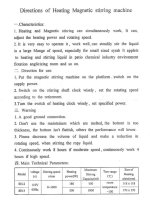Not So Fine Print - Assembly Instructions
I had a Misfortune and/or Misadventure buying and installing a Baby Gate in a doorway.
Regalo brand from Walmart.
The Instruction sheet has several languages.
All in VERY SMALL PRINT.
Their font size is noticeably SMALLER than that of the "LIBERTY" printed on a United States Quarter Dollar.
In addition to the Instruction Sheet were two INCORRECT unmentioned strips
detailing mounting hole placements for hardware to be installed on the walls.
These had instructions to "cut here" for floor.
Put edge on floor with strip running up the wall for mounting.
Oh so Simple - BRAVO SIERRA!
Marked Hole Pattern was WRONG!
Both paper strips were the same.
But, the lower bracket for one side had DIFFERENT screw Spacing.
The hardware mounting for the second wall is
DRILL TO FIT after hanging the gate on hinges mounted on first wall.
Yes the first wall was the one with the wrong hole pattern.
I will skip further details of this FIASCO!
Bekeart
I had a Misfortune and/or Misadventure buying and installing a Baby Gate in a doorway.
Regalo brand from Walmart.
The Instruction sheet has several languages.
All in VERY SMALL PRINT.
Their font size is noticeably SMALLER than that of the "LIBERTY" printed on a United States Quarter Dollar.
In addition to the Instruction Sheet were two INCORRECT unmentioned strips
detailing mounting hole placements for hardware to be installed on the walls.
These had instructions to "cut here" for floor.
Put edge on floor with strip running up the wall for mounting.
Oh so Simple - BRAVO SIERRA!
Marked Hole Pattern was WRONG!
Both paper strips were the same.
But, the lower bracket for one side had DIFFERENT screw Spacing.
The hardware mounting for the second wall is
DRILL TO FIT after hanging the gate on hinges mounted on first wall.
Yes the first wall was the one with the wrong hole pattern.
I will skip further details of this FIASCO!
Bekeart


